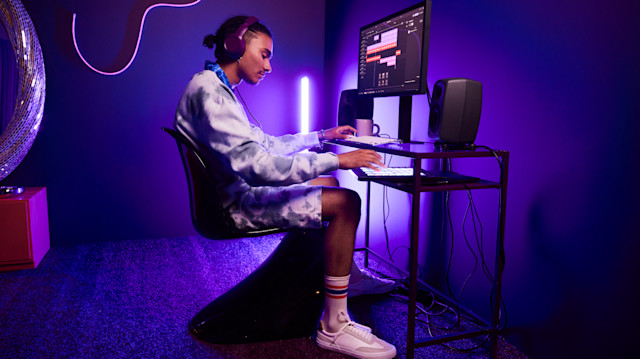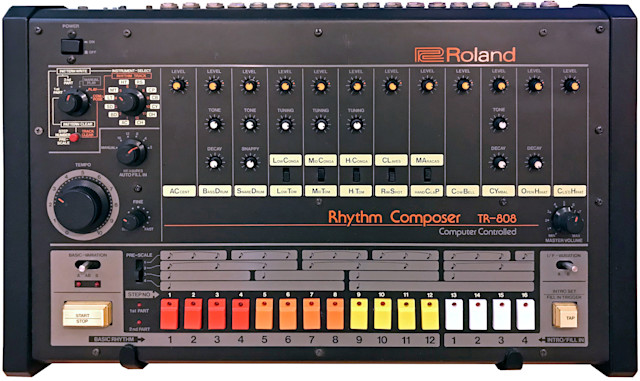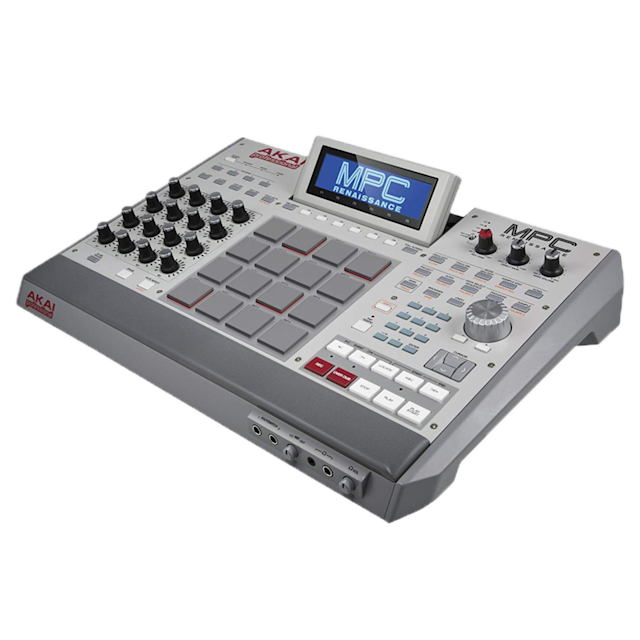The History of The Drum Machine: How Music Became Digital
December 19, 2023 | Anton Berner

No exaggeration, the drum machine changed humanity's course. What is a drum machine? Originally meant to mimic human drummers, these devices are more than just simple percussion instruments. Drum machines birthed entirely new electronic music genres and created new cultures around the world.
For instance, without the Roland TR-909 and TR-808, House, EDM, and Hip Hop wouldn't exist. But how does a drum machine work and how did this tech start and evolve into digital drum machines in the digital era?
This article highlights influential drum machines throughout the 1900s, from the early Wurlitzer Sideman to virtual drum machines in modern digital audio workstations (DAWs), emphasizing the transition from analog to digital technology in music.

The Wurlitzer Sideman Drum Machine invented in the 1950s
1950s-1960s: The Wurlitzer Sideman Drum Machine
Launched in 1959, the Wurlitzer Sideman is one of the first drum machines ever created, marking a significant moment in the history of different drum machines. It looks nothing like today's versions, but it was a big step for electronic music.
The Sideman didn't use digital samples or analog synthesis. Instead, it used electromechanical tech. It had a spinning disc with contact points to make drum sounds like bass drums, snares, brushes, cymbals, and tambourines.
It also had preset rhythms for popular styles like waltzes and sambas. Nowadays, drum machines are linked to genres like techno and hip-hop, but the Sideman was different. It was mostly used as an accompaniment for organists.
Organists liked the Sideman since it fit places where a full drum kit wouldn't work. But it wasn't particularly small or portable either. The Sideman was big and bulky, sitting in a wooden cabinet.
Even with its size and limited options, the Wurlitzer Sideman marked the shift from traditional drums to electronic ones. Its mechanical design paved the way for fully electronic drums that came later.

The Roland TR-77 drum machine
1970s: Roland TR-77
You've probably heard of Roland's drum machines, like the famous 909 and 808. But did you know about the Roland TR-77? Made in the early '70s, it was one of their first drum machines.
Like its predecessor, the Wurlitzer Sideman, it focused on preset patterns. The big difference? The TR-77 used electronic analog circuit components for its drum sounds. Say goodbye to the Sideman's mechanical discs!
The TR-77 had a unique electronic tone. But it wasn't used much in professional music production. Still, it paved the way for Roland's future drum machine innovations.

Roland TR-808 Drum Machine
1980s: Roland TR-808
Though many early drum machines faded into obscurity, the Roland 808 from 1980 remains a staple in electronic music. You could say the TR-808 is a game-changer in this genre. Its unique sound, known for its booming bass drum and crisp snare, has left an undeniable mark.
Even if you're unfamiliar with the 808, you've probably heard its sound. It's certainly not a realistic drum kit emulation; it's distinctively artificial and synthetic. This quality initially made the 808 a commercial flop since people wanted more authenticity.
Read more: The 808 – Origins & Use in Music Production Today
Due to its unconventional sound, the TR-808 didn't sell well at first. Retailers slashed prices to clear stock, making it more affordable than other pricey drum machines. This allowed budget-conscious artists in hip-hop and electronic dance music scenes to experiment with the 808.
These musicians found a powerful, intuitive interface that enabled complex drum patterns and song sequences. Electronic producers could create entire tracks with the 808 as their centerpiece. Suddenly, everyone wanted to know how to use a drum machine.
Thanks to its adoption by emerging artists, the 808 became one of the most popular and sought-after drum machines ever. Despite its affordability in the '80s, today's demand has driven up prices considerably.

Linn LM-1
1980s: Linn LM-1
The 808 tried but failed to make realistic drum sounds with analog synthesis. In 1980, Linn Electronics introduced the Linn LM-1, which nailed it. It used a simple yet revolutionary method: playing back digital samples of real acoustic drums instead of real-time synthesized analog sounds.
Since the LM-1's sounds were actual recorded drum samples, it was way more realistic than its analog counterparts. Like the 808, it could be programmed and sequenced like never before. Musicians could create beats and chain them together to create a whole composition.
The LM-1 left a huge mark on music culture, and it was used on hit records by legends like Prince and Michael Jackson. Its use of digital samples over analog sounds was a game-changer in electronic music, paving the way for genres like hip-hop, drum and bass, and other sample-based music.

The Roland TR-909
1980s: Roland TR-909
The Roland TR-909, developed in 1983, is a drum machine that made a huge impact on music. Like the TR-808, you can hear the TR-909 everywhere in electronic music styles like techno, house, and acid house. Its drum sounds are super distinctive. Even if you don't know the TR-909 by name, you'll recognize its sounds.
What sets the TR-909 apart from the TR-808 is its heavy kick drum sound, perfect for using a drum machine for pounding techno rhythms. The 909's punchy sounds were great for clubs, so many classic dance hits used a 909.
The 909 is different from the 808 because it uses hybrid sound generation, mixing analog synthesis and digital sampling. Creating synthetic drum sounds like bass drums and snares is possible, but cymbals are harder to synthesize convincingly.
So, the 909 used sample-based cymbals and hi-hats while keeping the other drums analog. This makes the 909's cymbals sound much more aggressive compared to the 808's more subdued analog hi-hats.

The EMU-SP12
1980s: EMU-SP12
The EMU-SP12 is a legendary drum machine with a huge impact on music history, representing significant music developments. What sets it apart from others? It had sampling capability.
So, not only did users get built-in drum sounds, but they could also sample and tweak sounds from external sources. This feature played a big role in the rise of sample-based genres like hip-hop.
Read more: The Sampler — A Guide to Sampling in Music
But compared to today's samplers, the SP12 was quite limited in sampling time and memory. The original version allowed only 5 seconds of audio! These limitations forced users to get creative with the device.
The gritty, warm sound of the SP12 wasn't intentional; it resulted from downsampling the audio. Downsampling reduces the sample rate or bit depth of audio, creating a lower fidelity sound but saving memory space. This gave the SP12 a unique lo-fi quality that sounded amazing in genres like hip-hop and house music. The reduced sample rate added crunchiness to the sound, making drum beats pop.
Even though downsampling isn't necessary today, many producers still use sounds sampled from the SP12 or use bitcrusher plugins to emulate its iconic sound. The SP12 marked a turning point in drum machines, just as the step sequencer had revolutionized music earlier. Being able to sample your own sounds was a game-changer for many producers.
Many aspiring hip-hop producers dug through their parents' record collections, finding a goldmine of sample-worthy tunes. For example, producers would frequently sample James Brown records, leading to drum breaks like those in his "Funky Drummer," becoming staples in hip-hop and breakbeat music.

The Akai MPC60
1980s-1990s: Akai MPC60
The Akai MPC-60 revolutionized music production as a highly influential drum machine. It is built on the SP-12, boasting a sophisticated sampling and sequencing system. With its powerful sampler and MIDI sequencer, producers could sample audio, program patterns, and sequence them in one machine.
While the MPC-60 is a drum machine, it's also a complete music production center. Hip-hop artists like J Dilla loved it, using it to create iconic beats. Like the SP-12, it used downsampling for memory efficiency, giving it a unique crunchy yet fat sound that's still popular today.
The MPC-60 marked a shift towards comprehensive audio workstations that went well beyond conventional drum machine capabilities.

Virtual Drum Machine in Soundtrap
1990s and beyond: Virtual Drum Machines in DAWs
Nowadays, an analog drum machine isn't a must-have, thanks to the advancement in digitalized music. As digital technology improved, computers started running advanced digital audio workstations (DAWs). These programs, like Soundtrap, let producers do complex MIDI sequencing and audio editing, epitomizing the shift toward digitalized music production.
DAWs now have built-in digital drum machines, like the Soundtrap Beatmaker, and Soundtrap’s Sampler for your own drum sounds, a testament to the evolution of drum machines online. No external hardware is needed! Just enter the online studio and pick the drum sound of your choice to start sequencing.
In the Soundtrap studio, you can also find samples, loops, and one-shots from popular drum machines such as the 808 and 909, keeping them relevant in modern DAWs and highlighting the seamless transition of these classic machines into the digital realm.
DAWs also allow for powerful sound synthesis within the software. They've evolved from music production stations/drum machines like the MPC-60 into much more. Unlimited sampling time and access to mixing effects make experimenting with sound a breeze - something '80s drum machine users could only dream of.
Soundtrap <3 Drums
Though drum machines in digital audio workstations offer endless creativity, there's still room for innovations to shake up the music industry. Soundtrap is a game-changing music software that is 100% online-based. This means your music projects are stored online and can be accessed anywhere from multiple devices.
Soundtrap also allows you to invite real-time collaborators to the studio. The project syncs between collaborators in the online project, so you can team up with artists and producers worldwide. All you need is an internet connection.
About the author
Anton Berner is a music producer, audio engineer, and songwriter from Stockholm, Sweden. He's produced hip-hop & rap music since the early 2000s and his expertise is in vocal mixing and sample-based beat production. Anton is also the SEO & Content Manager @ Soundtrap and manages the blog and newsroom.
Get started with Soundtrap today!